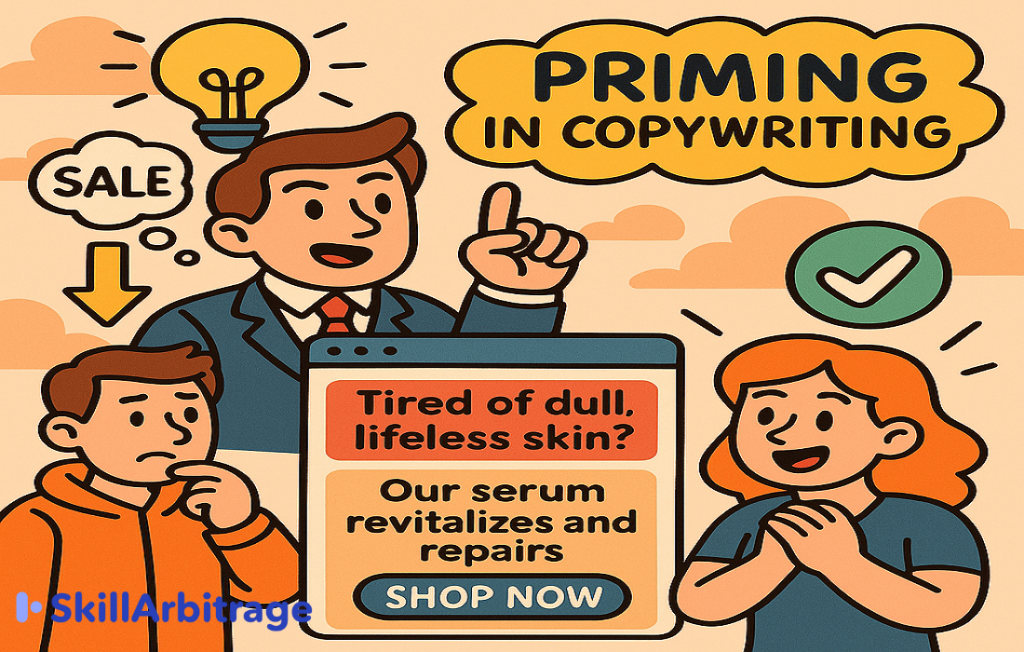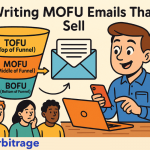This article takes a close look at priming in copy and shows how this technique can be used to drive conversions faster. This would be very useful for content writers, marketers, and copywriters interested in driving conversions through content alone.
Introduction
On your last visit to the dentist, do you remember him or her telling you “This will hurt” before he started to work on your teeth, or a friend asking you to watch a series and opening with “It’s really good!”
We say things like these unconsciously to create anticipation and set a tone.
Do you know what businesses use it for?
To ensure sales.
Have you ever seen a copy like “This one mistake ruined my skin barrier” and suddenly you must know more?
That’s not just clever phrasing. It’s priming, a psychological trigger that subtly shapes how your brain reacts to everything that follows.
In copywriting, the first words act like a lens. Once you’ve set the filter, your reader views the rest of your copy through it.
Whether you’re writing landing page copy for a SaaS tool or Instagram captions for a skincare brand, if your first line doesn’t set the right tone, your audience might never make it to your CTA.
Let’s break it down.
What is priming?
In psychology, priming is when exposure to one stimulus influences how we respond to the next.
If you read the word “struggle” in a headline, you subconsciously brace yourself for a challenge or solution in the rest of the message. If you see “free,” your brain goes into bargain-hunting mode. If you see “danger,” you switch to high-alert scanning.
So, the first line of your copy primes perception, mood, attention, and even trust.
This is why high-converting copywriters obsess over all three parts of the copy: headline, subhead, and CTA, not just what it says, but how each element flows effortlessly and sets the stage for the next.
When done right, priming can have a fantastic impact on the conversion rates.
Why Indian brands need to get better at priming
A lot of Indian brands still masquerade a lack of memorability or style as clarity. Their copy skips the warm-up and jumps straight to the pitch:
“We offer the best AI-based CRM solution for fast-growing teams.”
“Buy our new vitamin C serum – now in 50 ml!”
The audience does not know why the CRM solution is best or what’s unique about the vitamin C serum.
The copy does not prime them to expect anything and delivers nothing. Such copy ultimately sinks into the wasteland of read and forgotten content. It’s like proposing marriage on the first date; you can be sure the answer will be a resounding “No.”
Instead, here’s how to set the tone and lead the conversion path with purpose.
The headline → subhead → CTA priming framework
Step 1: Headline = Emotional filter
Set the mood. Create tension. Invoke desire, frustration, relief, or curiosity.
Step 2: Subhead = Mental framing
Give context. What’s this about? Why should I care now?
Step 3: CTA = Logical action
Close the loop. Give them an action that feels like a natural, frictionless next step.
Let’s test this formula across mediums to see how it fares.
SaaS example: B2B workflow automation tool ad
Bad priming flow:
Headline: “Automate Your Business Processes”
Subhead: “Streamline daily operations and improve productivity”
CTA: “Start Free Trial”
This flow is neutral. No tension, no emotional pull, no urgency. It feels like brochureware.
Primed flow:
Headline: “Still using spreadsheets to track leads?”
Subhead: “Teams lose up to 30% productivity to manual workflows. Let’s fix that in 5 clicks.”
CTA: “Automate My Workflow (Free)”
This flow uses discomfort and relevance to build urgency, contextualizes the cost of inaction, and closes with an empowering action.
Skincare brand example: Vitamin C Serum landing page
Bad priming flow:
Headline: “Glow Like Never Before”
Subhead: “With our dermatologist-approved formula”
CTA: “Shop Now”
Here the flow is too generic. No insight into skin issues. Doesn’t challenge or connect emotionally.
Primed flow:
Headline: “Tired of dull, lifeless skin that never seems to heal?”
Subhead: “This vitamin C serum doesn’t just promise glow. It repairs years of sun damage, pigmentation, and neglect — clinically proven.”
CTA: “Start Skin Recovery Today”
This sequence taps into frustration, reframes it with a solution, and guides the reader to act with purpose.
Is priming the same thing as a hook, then?
Not really.
The difference between priming and a hook in copywriting
Both priming and hooks are psychological tools used in copywriting to grab attention and influence behavior. But, they serve different purposes and operate at different levels of the audience’s awareness.
Here are the differences:
Hooks grab attention
The hook is the first punch.
It’s the headline, first sentence, or visual that stops the scroll and compels your audience to read or watch more.
Think of it like a pickup line. It has one job:
Make the reader say: “Wait, what?”
Examples of hooks:
- “You’re losing ₹50,000 a year and don’t even know it.”
- “What IIT didn’t teach me, freelancing did.”
- “This one app made me ₹4 lakh from my sofa.”
What hooks do:
- They grab attention.
- They create curiosity or an emotional connection.
- They appear at the beginning of the content (headline, subject line, video intro).
Priming prepares the mind
Priming is more subtle. It’s the psychological setup that influences how the reader will interpret or feel about what comes next.
It’s like setting the mood before telling a story, so the punchline hits harder.
How it works:
- You hint at a pain point, fear, or desire early on.
- You plant a word, phrase, or image that influences how the reader will receive the core message.
- You guide their brain to be more receptive to your pitch.
Examples of Priming:
Let’s say you want the reader to value your product’s speed.
You can prime their brain by highlighting how slow the current solution is:
Weak: “This app saves time.” – Just a feature.
Stronger: “Still wasting 3 hours a week doing this manually?” – Now, the benefit of speed is emotionally charged.
Priming sets the emotional and mental context for your key message. A hook is like saying, “Hey! Look at this!”. Priming is like shaping their inner dialogue to say,
“This is going to be important. Pay attention to this kind of thing.”
Where does priming fit in the funnel?
How hook and priming work together
Hook:
“Why I stopped using Google Docs — even for million-rupee clients.”
Priming:
“I used to think design didn’t matter for writing. But then I realized something strange: my most boring-looking proposals always got ignored.”
Payoff:
“That’s when I switched to [AI tool] — and my client conversions shot up.”
Interested in trying this out for yourself? Grab these templates to prime anybody, at any time.
Three priming templates you can use today
Ready to turn a flat copy into a conversion machine? Use these three priming templates tailored for Indian audiences, tapping into local pain points and cultural triggers.
Sell anything from SaaS tools to skincare products with these templates, and watch your audience lean in.
Pain-first framing (intech SaaS Example)
Headline: “Still wasting hours on manual GST filings every month?”
Subhead: “Over 15,000 Indian businesses save 10+ hours a week with our automated tax tool.”
CTA: “Simplify My Taxes Now (Free Trial)”
Why it works: The headline taps into the frustration of tedious GST compliance, a common pain point for Indian businesses. The subhead uses social proof (15,000 businesses) to build trust, and the CTA offers a low-friction solution.
False-belief breaking (EdTech example)
Headline: “Think you need an MBA to land high-paying clients?”
Subhead: “Our freelancing course helped 5,000+ Indians earn ₹2 lakh+ from home — no degree required.”
CTA: “Start Learning for Free”
Why it works: The headline challenges a common Indian belief that formal degrees are essential for success. The subhead reframes success as achievable, and the CTA invites exploration without risk.
Loss-framed priming (Skincare e-commerce example)
Headline: “Is dull skin costing you confidence in every selfie?”
Subhead: “Our vitamin C serum reverses pigmentation and sun damage — trusted by 10,000+ Indian women.”
CTA: “Get My Glow Back Today”
Why it works: The headline connects to the emotional pain of low confidence, resonant in the new selfie-driven culture. The subhead offers a solution with social proof, and the CTA feels personal and empowering.
These templates work because they prime your audience emotionally, contextually, and actionably, perfect for India’s value-driven market.
Quick test: flat copy vs. primed copy
Try this side-by-side experiment:
Which one would you click? Always the one sold by the primed copy.
Final word
Priming is like the first note in a song. Get it right, and your audience leans in.
Get it wrong, and they scroll right past.
When you treat every headline, subhead, and CTA as a psychological sequence—not just filler—you start shaping outcomes, not just writing content. Please comment to let me know if the priming techniques and templates were useful.
FAQs
Q1. What’s the difference between a primed and a non-primed CTA?
A primed CTA is context-aware. It’s framed by the problem and builds momentum.
Example:
Non-primed: “Get Started”
Primed: “Fix My Workflow Today” (after a pain-based headline)
Q2. How can I test if my priming is working?
Run A/B tests on landing pages or emails using different headlines → subheads → CTA flows.
Track CTRs, bounce rate, and scroll depth. Primed flows usually outperform flat ones in both click-through and time-on-page.
Q3. Can I use priming in short-form content like Instagram captions?
Absolutely.
Use the first line to trigger curiosity or relatability.
Example: “My skin was peeling off and nothing helped — until this.”
This primes the reader emotionally and increases read-through.
Q4. How do I avoid sounding clickbait-y?
Stick to emotional truth. Don’t exaggerate.
You can use tension (frustration, fear, desire) without lying. Authenticity and social proof in the subhead will back your claim.
Q5. What if I’m writing for a low-interest category like insurance or SaaS?
That’s where priming matters even more. Use relatable pain points, reframe boredom as a hidden cost, and always build the story toward a solution.







 Allow notifications
Allow notifications
